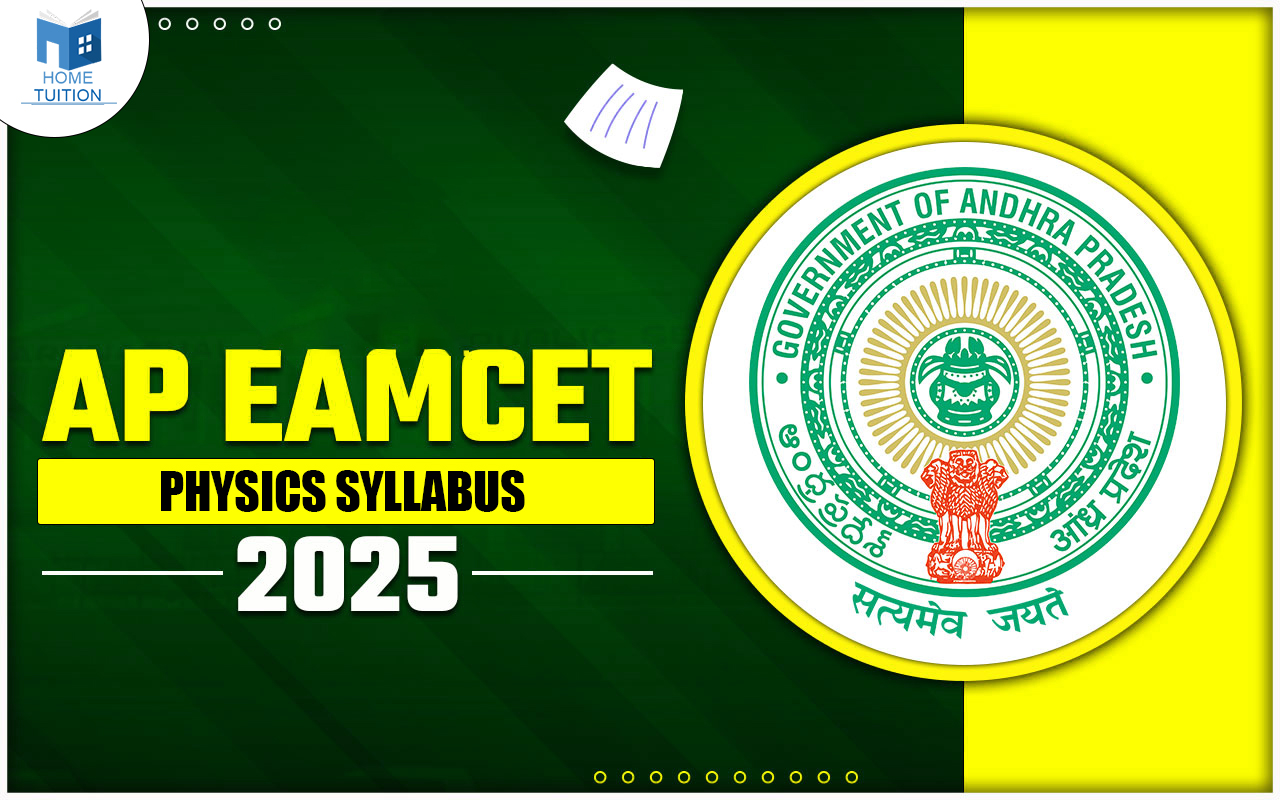| S.no. | Chapter-Wise AP EAMCET 2025 Physics Syllabus |
|---|
AP EAMCET 2025 Physics Syllabus
The Physics section is common to both Engineering and Agricultural streams, with 40 questions each carrying 1 mark. Importantly, there is no negative marking.
| Chapter | Sub-Topics |
| Dimensions and Units, Measurements |
|
| Elements of Vector |
|
| Kinematics |
|
| Laws of motion |
|
| Energy and Power, Work |
|
| Gravitation |
|
| Mechanical Properties of solids |
|
| Mechanical Properties of fluids |
|
| Thermal Properties of Matter |
|
| Thermodynamics |
|
| Kinetic Theory |
|
| Waves |
|
| Ray Optics and Optical Instruments |
|
| Wave Optics |
|
| Electric Charges and Fields |
|
AP EAMCET Physics Important Topics 2025
Some of the important topics from the AP EAMCET 2025 Physics Syllabus based on past years’ trends are listed below. Candidates should focus on these topics for reference purposes, although the weightage may vary each year.
| Chapter | Weightage (Approx.) |
| Thermodynamics | 9% |
| Physical World | 1% |
| Waves | 4% |
| Motion in a straight line | 3% |
| Wave Optics | 3% |
| Laws of Motion | 5% |
| Work, Energy, and Power | 6% |
| Electromagnetic Induction | 3% |
| Semiconductor Electronics | 3% |
| Gravitation | 4% |
| Mechanical Properties of Solids | 2% |
| Mechanical Properties of Fluids | 3% |
| Thermal Properties of Matter | 3% |
| Units and Measurements | 2% |
| Motion in a Plane | 5% |
| Kinetic Theory | 2% |
| Ray Optics and Optical Instruments | 3% |
| System of Particles and Rotational Motion | 6% |
| Electric Charges and Fields | 3% |
| Oscillations | 4% |
| Current Electricity | 4% |
| Moving Charges and Magnetism | 5% |
| Magnetism and Matter | 2% |
| Atoms | 2% |
| Alternating Current | 3% |
| Electromagnetic Waves | 2% |
| Dual Nature of Radiation and Matter | 3% |
| Nuclei | 3% |
| Electrostatic Potential and Capacitance | 4% |
| Communication Systems | 3% |
Best Books for AP EAMCET 2025 Physics Preparation
There are numerous resources available in the market to help students prepare for the AP EAMCET 2025 exam. To assist candidates in securing a good rank, we've compiled a list of some of the best books specifically for the AP EAMCET 2025 Physics preparation. These books cover essential topics and the entire syllabus of AP EAMCET Physics 2025.
| Name of the Book | Author/Publisher |
| Problems in Physics | S.S. Krotov-HC Verma |
| EAPCET Physics (Andhra Pradesh & Telangana) | Arihant Experts |
| Physics for IIT-JEE | Resnick Halliday, Walker |
| IIT JEE Physics | DC Pandey |
| Problems in General Physics | I.E. Irodov |
| EAPCET Physics (Andhra Pradesh & Telangana) | Arihant Experts |
| Concepts of Physics (Volume – 1 and 2) | HC Verma |
| Key Notes Terms, Notes, Formula | Arihant Experts |
AP EAMCET 2025 Physics Exam Marking Scheme
Understanding the marking scheme is essential for effective preparation. The following table outlines the marking scheme for the AP EAMCET 2025 exam:
| Subject | Total No. of Questions | Total Marks |
| Physics | 40 | 40 |
| Chemistry | 40 | 40 |
| Mathematics | 80 | 80 |
| Total | 160 | 160 |
By thoroughly studying the AP EAMCET Physics Important Topics 2025 and referring to the right materials, students can effectively prepare for the AP EAMCET 2025 Physics Syllabus and increase their chances of success in the exam. Make sure to stay updated with the complete AP EAMCET Syllabus 2025 and focus on the list of Physics chapters and topics that carry the most weight in the AP EAMCET's Physics syllabus.
Frequently Asked Questions
To score 100 marks in AP EAMCET 2025, candidates should create a well-organized study plan. It’s essential to prioritize practicing previous years’ papers, mock tests, and sample papers. Focus on chapters with higher weightage, and make sure to refer to AP EAMCET 2025 Books for complete syllabus coverage. Understanding the AP EAMCET 2025 syllabus thoroughly will help in better preparation.
The AP EAMCET 2025 exam syllabus can be challenging, but it’s not necessarily difficult if you prepare well and have a strong grasp of the core subjects. The AP EAMCET 2025 exam tests your understanding of concepts and problem-solving skills in Mathematics, Physics, and Chemistry. Familiarity with the AP EAMCET 2025 syllabus, especially the Physics section, will ease the preparation process.
Cracking the AP EAMCET 2025 exam can be tough due to high competition, as around two lakh candidates appear for this exam every year. To succeed, you need a solid AP EAMCET 2025 study plan and a strict timetable. It’s also crucial to be well-versed with the AP EAMCET 2025 syllabus and exam pattern to enhance your preparation strategy.
If a candidate scores between 40 and 49 marks in AP EAMCET, the expected rank might fall between 30,001 and 40,000. However, the rank can vary depending on the overall performance of candidates in the AP EAMCET 2025 exam.
The AP EAMCET 2025 Physics syllabus includes topics such as Dimensions and Units, Measurements, Elements of Vectors, Kinematics, and Laws of Motion. It’s important to go through the list of Physics chapters and topics in the AP EAMCET 2025 Physics syllabus to focus on AP EAMCET Physics Important Topics 2025. Understanding the syllabus of AP EAMCET Physics 2025 will help you prepare effectively for the exam.
